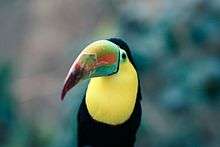Toucan
| Toucan Temporal range: 2–0 Ma Early Pleistocene – Recent | |
|---|---|
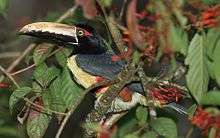 | |
| Collared aracari (Pteroglossus torquatus) | |
| Scientific classification | |
| Kingdom: | Animalia |
| Phylum: | Chordata |
| Class: | Aves |
| Order: | Piciformes |
| Infraorder: | Ramphastides |
| Family: | Ramphastidae Vigors, 1825 |
| Genera | |
Toucans (pronounced /ˈtuːkæn/) are members of the family Ramphastidae of near passerine birds from the Neotropics. The Ramphastidae family is most closely related to the American barbets. They are brightly marked and have large, often-colorful bills. The family includes five genera and over forty different species.æn
Taxonomy and systematics
The name of this bird group is derived from the Tupi word tukana, via Portuguese.[1] The family includes toucans, aracaris and toucanets; more distant relatives include various families of barbets and woodpeckers in the suborder Pici.
Systematic list
- Genus Aulacorhynchus — green toucanets (11 species)
- Genus Pteroglossus — araçaris (14 species)
- Genus Selenidera — dichromatic toucanets (6 species)
- Genus Andigena — mountain toucans (4 species)
- Genus Ramphastos — typical toucans (8 species)
Description
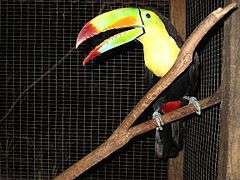
Toucans range in size from the lettered aracari (Pteroglossus inscriptus), at 130 g (4.6 oz) and 29 cm (11.5 inches), to the toco toucan (Ramphastos toco), at 680 g (1.5 lb) and 63 cm (29 inches). Their bodies are short (of comparable size to a crow's) and compact. The tail is rounded and varies in length, from half the length to the whole length of the body. The neck is short and thick. The wings are small, as they are forest-dwelling birds who only need to travel short distances, and are often of about the same span as the bill-tip-to-tail-tip measurements of the bird.
The legs of the toucan are strong and rather short. Their toes are arranged in pairs with the first and fourth toes turned backward. The majority of toucans do not show any sexual dimorphism in their coloration, the genus Selenidera being the most notable exception to this rule (hence their common name, "dichromatic toucanets"). However, the bills of female toucans are usually shorter, deeper and sometimes straighter, giving more of a "blocky" impression compared to male bills. The feathers in the genus containing the largest toucans are generally black, with touches of white, yellow, and scarlet. The underparts of the araçaris (smaller toucans) are yellow, crossed by one or more black or red bands. The toucanets have mostly green plumage with blue markings.
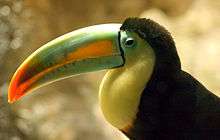
The colorful and large bill, which in some large species measures more than half the length of the body, is the hallmark of toucans. Despite its size, the toucan's bill is very light, being composed of bone struts filled with spongy tissue of keratin[2] between them. The bill has forward-facing serrations resembling teeth, which historically led naturalists to believe that toucans captured fish and were primarily carnivorous; today it is known that they eat mostly fruit. Researchers have discovered that the large bill of the toucan is a highly efficient thermoregulation system, though its size may still be advantageous in other ways.[3][4] It does aid in their feeding behavior (as they sit in one spot and reach for all fruit in range, thereby reducing energy expenditure), and it has also been theorized that the bill may intimidate smaller birds, so that the toucan may plunder nests undisturbed (see Diet below). Also, the beak allows the bird to reach deep into tree-holes to access food unavailable to other birds, and also to ransack suspended nests built by smaller birds. However, as there is no sexual dimorphism in coloration it is unlikely to be a sexual signal.
A toucan's tongue is long (up to 14–15 cm, or 6 inches), narrow, grey, and singularly frayed on each side, adding to its sensitivity as an organ of taste.
A structural complex probably unique to toucans involves the modification of several tail vertebrae. The rear three vertebrae are fused and attached to the spine by a ball and socket joint. Because of this, toucans may snap their tail forward until it touches the head. [5] This is the posture in which they sleep, often appearing simply as a ball of feathers, with the tip of the tail sticking out over the head.
Distribution and habitat
Toucans are native to Southern Mexico, Central America, the northern part of South America (where they are known as the Brazilian goose), and the Caribbean region. They generally live in tropical and sub-tropical regions.
Toucans are arboreal and typically lay 2–21 white eggs in their nests. They make their nests in tree hollows and holes excavated by other animals such as woodpeckers—the toucan bill has very limited use as an excavation tool. When the eggs hatch, the young emerge completely naked, without any down. Toucans are resident breeders and do not migrate. Toucans are usually found in pairs or small flocks. They sometimes fence with their bills and wrestle, which scientists hypothesize they do to establish dominance hierarchies.
Behaviour and ecology
Diet
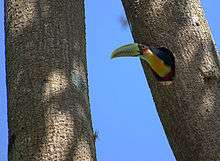
Toucans are primarily frugivorous (fruit eating), but are opportunistically omnivorous and will take prey such as insects and small lizards.[6] Captive toucans have been reported to hunt insects actively in their cages, and it is possible to keep toucans on an insect-only diet. They also plunder nests of smaller birds, taking eggs and nestlings.[7][8] This probably provides a crucial addition of protein to their diet. Certainly, apart from being systematically predatory as well as frugivorous, like many omnivorous birds, they particularly prefer animal food for feeding their chicks.[9] However, in their range, toucans are the dominant frugivores, and as such, play an extremely important ecological role as vectors for seed dispersal of fruiting trees.[10]
In popular culture
The mascot of the Brazilian Social Democracy Party is a blue and yellow colored toucan; party members are called tucanos for this reason.
In Dora the Explora, The character Señor túcan is a spanish speaking toucan who occasionally gives Dora and her friends advice.
The Toucan Tecs was a 1992 UK Television cartoon, broadcast on CiTV, about two detective toucans named Zippi and Zac.
The constellation Tucana, containing most of the Small Magellanic Cloud, is named after the toucan.
The mascot of the Kellogg's brand cereal Froot Loops is Toucan Sam.
Two toucans appear in the animated film Rio.
During the 1930s and 1940s Guinness (beer) advertising often featured a toucan.
In the 2016 Nintendo 3DS game, Pokemon Sun and Moon, the Pokemon Toucannon was modeled after a Toco Toucan[11]
See also
References
- ↑ "Vocabulário Tupi-Português do Curso Elementar de Tupi Antigo" (in Portuguese). Universidade de São Paulo. Retrieved 1 June 2015.
- ↑ "Pulse – Spring 2005 newsletter". University of California, San Diego Jacobs School of Engineering. Spring 2005. Retrieved 2009-06-29. External link in
|publisher=(help) - ↑ Tattersall, G. J.; Andrade, D. V.; Abe, A. S. (2009). "Heat Exchange from the Toucan Bill Reveals a Controllable Vascular Thermal Radiator". Science. 325 (5939): 468–70. doi:10.1126/science.1175553. PMID 19628866.
- ↑ "Hot secret behind toucan's bill". BBC News. 23 July 2009.
- ↑ Reynolds, J. (2003). "Handbook of the Birds of the World, Vol. 7. Jacamars to Woodpeckers". Biological Conservation. 111 (2): 280. doi:10.1016/S0006-3207(02)00275-6.
- ↑ Remsen Jr, J.V.; Hyde, Mary Ann; Chapman, Angela (1993). "The Diets of Neotropical Trogons, Motmots, Barbets and Toucans". The Condor. 95 (1): 178–92. doi:10.2307/1369399. JSTOR 1369399.
- ↑ Nadkarni, Nalini M. ; Wheelwright, Nathaniel T. (Editors). Monteverde: Ecology and Conservation of a Tropical Cloud Forest. Publisher: Oxford University Press, 2000. ISBN 978-0-19-513310-3
- ↑ Robinson, S.K. (1985). "Coloniality in the Yellow-Rumped Cacique as a Defense against Nest Predators" (PDF). Auk. 10 (3): 506–19.
- ↑ Short, Lester; Horne, Jennifer. Toucans, Barbets and Honeyguides. Publisher: Oxford University Press 2002. ISBN 978-0-19-854666-5
- ↑ Pizo, M.A.; Donatti, C.I.; Guedes, N.M.R.; Galetti, M. (2008). "Conservation puzzle: Endangered hyacinth macaw depends on its nest predator for reproduction" (PDF). Biological Conservation. 141 (3): 792–96. doi:10.1016/j.biocon.2007.12.023.
- ↑ http://www.serebii.net/pokedex-sm/733.shtml
External links
| Wikimedia Commons has media related to Ramphastidae. |
| Look up toucan in Wiktionary, the free dictionary. |
